 Technology peripherals
Technology peripherals
 AI
AI
 Within 24 hours and $200 to copy the RLHF process, Stanford open sourced the 'Alpaca Farm'
Within 24 hours and $200 to copy the RLHF process, Stanford open sourced the 'Alpaca Farm'
Within 24 hours and $200 to copy the RLHF process, Stanford open sourced the 'Alpaca Farm'
At the end of February, Meta open sourced a large model series, LLaMA (literally translated as alpaca), with parameters ranging from 7 billion to 65 billion, which is called the prototype of the Meta version of ChatGPT. Afterwards, institutions such as Stanford University and the University of California, Berkeley, carried out "secondary innovations" based on LLaMA, and successively launched multiple open source large models such as Alpaca and Vicuna. For a time, "Alpaca" became the top model in the AI circle. These ChatGPT-like models built by the open source community iterate very quickly and are highly customizable. They are called the open source replacement of ChatGPT.
However, the reason why ChatGPT can show powerful capabilities in text understanding, generation, reasoning, etc. is because OpenAI uses a new training paradigm-RLHF for large models such as ChatGPT. (Reinforcement Learning from Human Feedback), which uses reinforcement learning to optimize the language model based on human feedback. Using RLHF methods, large language models can be aligned with human preferences, follow human intent, and minimize unhelpful, distorted, or biased output. However, the RLHF method relies on extensive manual annotation and evaluation, which often requires weeks and thousands of dollars to collect human feedback, which is costly.
Now, Stanford University, which launched the open source model Alpaca, has proposed another simulator - AlpacaFarm (literally translated as alpaca farm). AlpacaFarm can replicate the RLHF process in 24 hours for only about $200, allowing open source models to quickly improve human assessment results, which can be called the equivalent of RLHF.

AlpacaFarm attempts to quickly and cheaply develop ways to learn from human feedback. To do this, the Stanford research team first identified three main difficulties in studying RLHF methods: the high cost of human preference data, the lack of trustworthy evaluations, and the lack of reference implementations.
To solve these three problems, AlpacaFarm built concrete implementations of simulation annotators, automatic evaluation, and SOTA methods. Currently, the AlpacaFarm project code is open source.
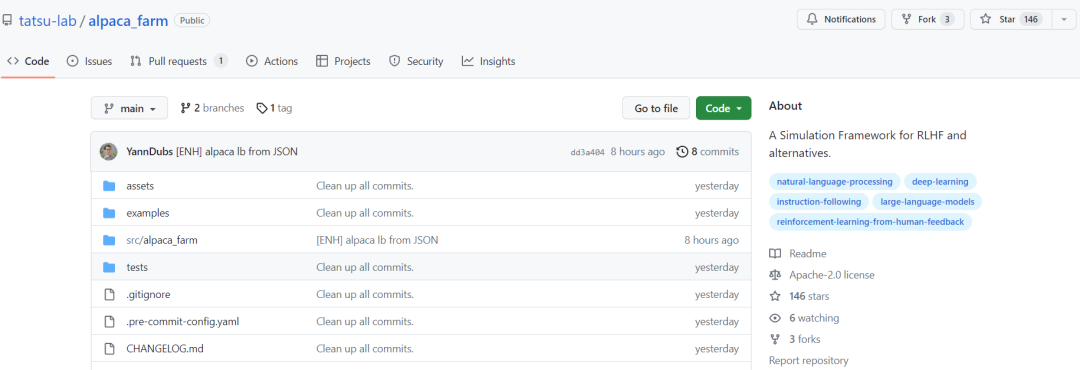
- GitHub address: https://github.com/tatsu-lab/alpaca_farm
- Paper address: https://tatsu-lab.github.io/alpaca_farm_paper.pdf
As shown in the figure below, researchers can use the AlpacaFarm simulator to quickly develop new methods of learning from human feedback data, and can also migrate existing SOTA methods to actual on human preference data.
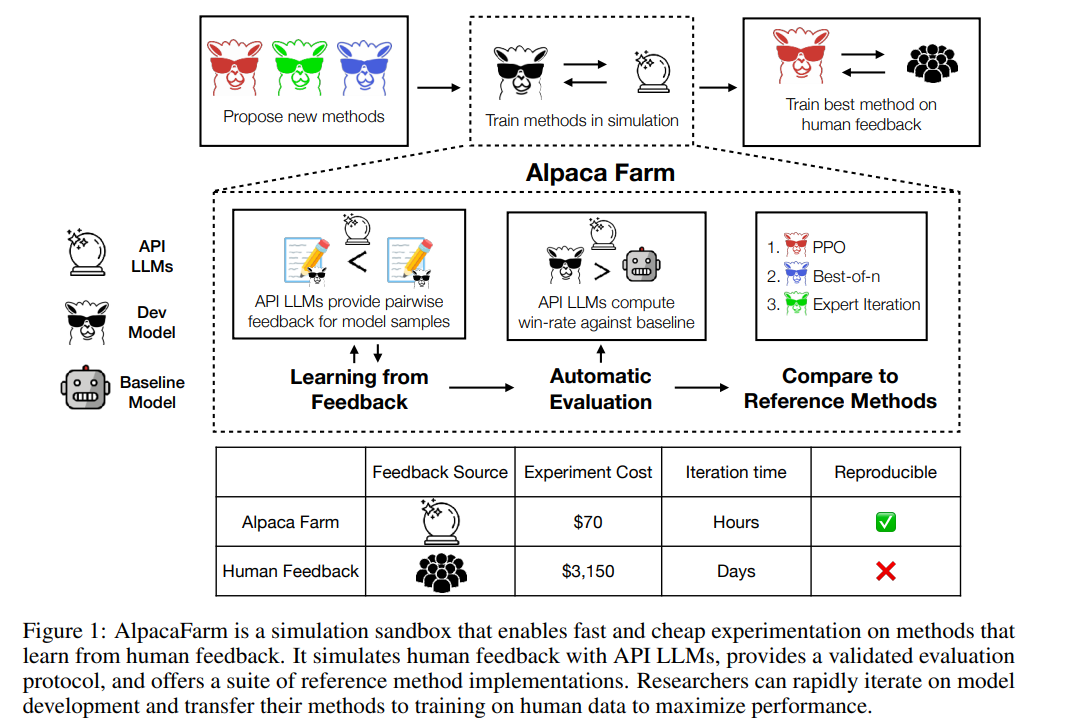
Simulation annotator
AlpacaFarm 52k instructions based on Alpaca dataset Build, of which 10k instructions are used to fine-tune the basic instruction following model, the remaining 42k instructions are used to learn human preferences and evaluation, and most of them are used to learn from simulated annotators. This study addresses the three major challenges of annotation cost, evaluation and verification implementation of the RLHF method, and proposes solutions one by one.
First, in order to reduce annotation costs, this study created prompts for API-accessible LLMs (such as GPT-4, ChatGPT), allowing AlpacaFarm to simulate human feedback at a cost of only RLHF Method 1/45 of the data collected. This study designed a random, noisy annotation scheme using 13 different prompts to extract different human preferences from multiple LLMs. This annotation scheme aims to capture different aspects of human feedback, such as quality judgments, variability between annotators, and style preferences.
The study experimentally demonstrates that AlpacaFarm’s simulations are accurate. When the research team used AlpacaFarm to train and develop methods, the methods ranked very consistently with the same methods trained and developed using actual human feedback. The figure below shows the high correlation in rankings between methods resulting from the AlpacaFarm simulation workflow and the human feedback workflow. This property is crucial because it shows that experimental conclusions drawn from simulations are likely to hold true in real situations.
In addition to method-level correlation, the AlpacaFarm simulator can also replicate qualitative phenomena such as reward model over-optimization, but continuous RLHF training for surrogate rewards may damage Model performance. The following figure shows this phenomenon in the two cases of human feedback (left) and AlpacaFarm (right). We can see that AlpacaFarm initially captures the correct deterministic behavior of model performance improvement, and then as RLHF training continues, model performance decreases.
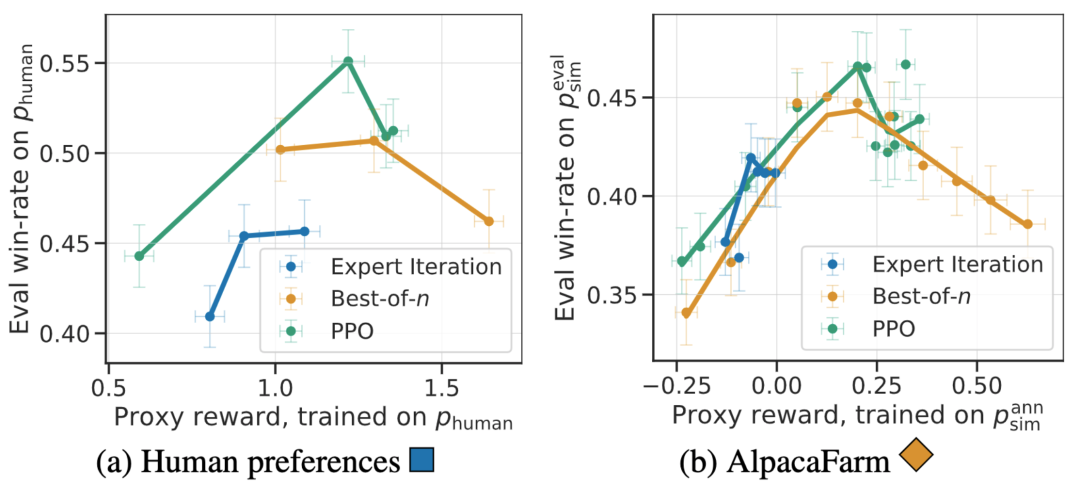
For evaluation, the research team used Alpaca 7B real-time user interaction as a guide, and simulates instruction distribution by combining several existing public datasets, including the self-instruct dataset, the anthropopic helpfulness dataset, and the evaluation sets of Open Assistant, Koala, and Vicuna. Using these evaluation instructions, the study compared the response of the RLHF model to the Davinci003 model and used a score to measure the number of times the RLHF model responded better, calling this score the win-rate. As shown in the figure below, a quantitative evaluation of system rankings on the study's evaluation data shows that system rankings and real-time user commands are highly correlated. This result shows that aggregating existing public data can achieve performance similar to simple real instructions.
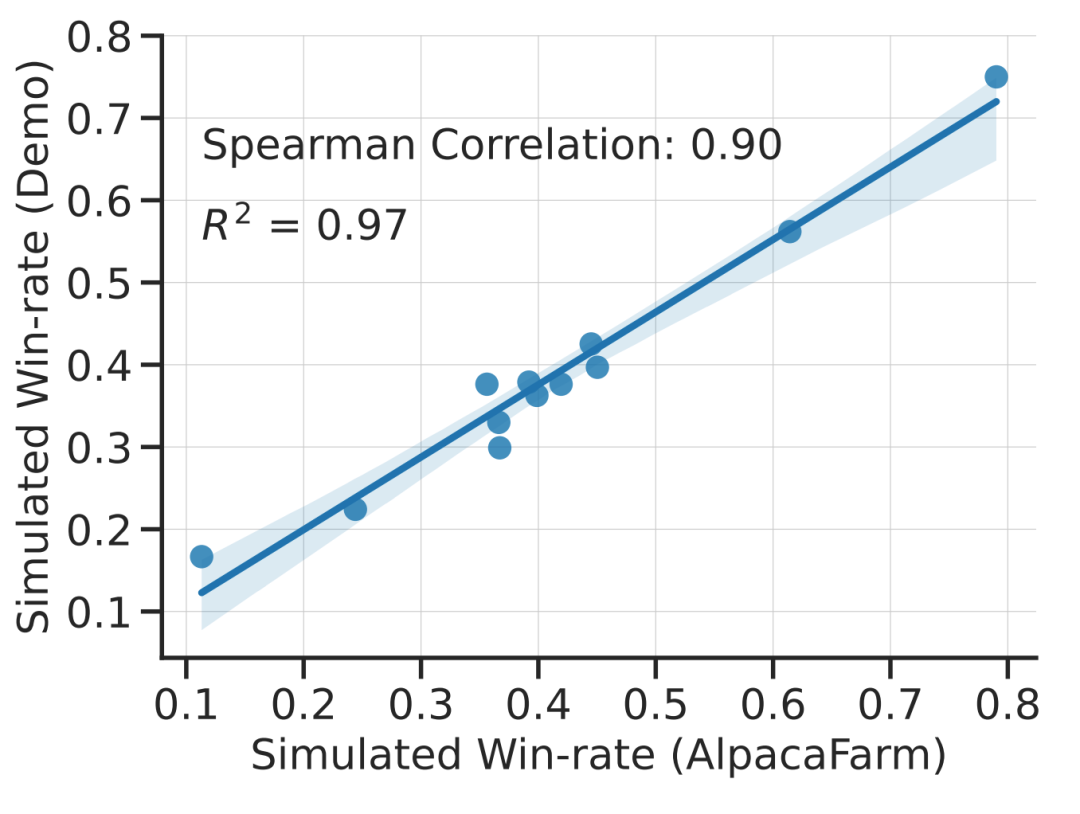
For the third challenge——Lack of reference Implementation,The research team implemented and tested several popular,learning algorithms (such as PPO, expert iteration, best-of-n,sampling). The research team found that simpler methods that worked in other domains were no better than the study's original SFT model, suggesting that it is important to test these algorithms in a real instruction-following environment.
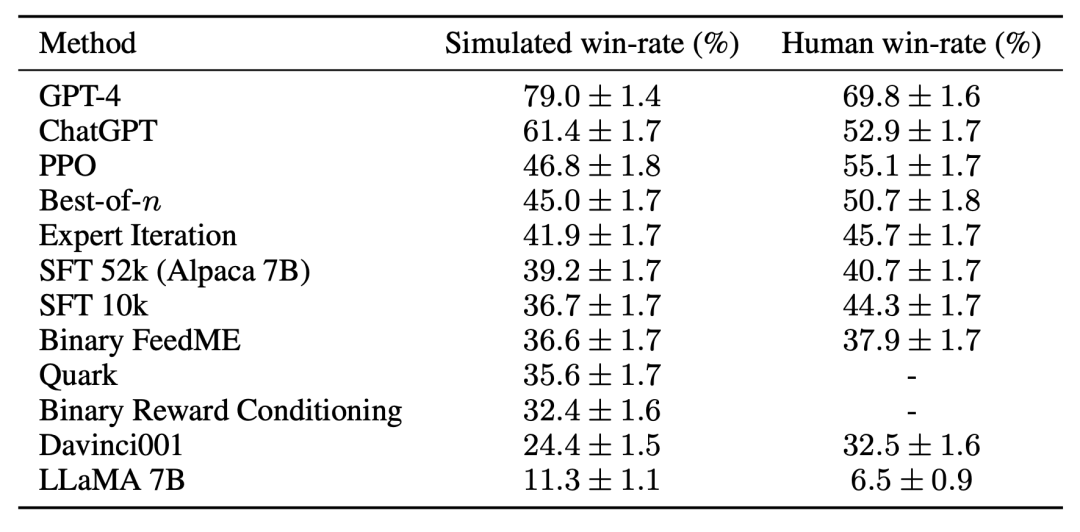
Based on manual evaluation, the PPO algorithm proved to be the most effective, combining the model with The winning rate compared to Davinci003 increased from 44% to 55%, even surpassing ChatGPT.
These results show that the PPO algorithm is very effective in optimizing the winning rate for the model. It is important to note that these results are specific to the evaluation data and annotators of this study. While the study's evaluation instructions represent real-time user instructions, they may not cover more challenging problems, and it is not certain how much improvements in win rate come from exploiting style preferences rather than factuality or correctness. For example, the study found that the PPO model produced much longer output and often provided more detailed explanations for the answers, as shown below:


Overall, using AlpacaFarm to train the model on simulated preferences can significantly improve the human evaluation results of the model without having to subject the model to Retraining on human preferences. Although this transfer process is fragile and still slightly less effective than retraining the model on human preference data. However, it can copy the RLHF pipeline within 24 hours with only $200, allowing the model to quickly improve human evaluation performance. The simulator AlpacaFarm is still too good. It is made by the open source community to replicate the powerful functions of models such as ChatGPT. Another effort.
The above is the detailed content of Within 24 hours and $200 to copy the RLHF process, Stanford open sourced the 'Alpaca Farm'. For more information, please follow other related articles on the PHP Chinese website!

Hot AI Tools

Undresser.AI Undress
AI-powered app for creating realistic nude photos

AI Clothes Remover
Online AI tool for removing clothes from photos.

Undress AI Tool
Undress images for free

Clothoff.io
AI clothes remover

Video Face Swap
Swap faces in any video effortlessly with our completely free AI face swap tool!

Hot Article

Hot Tools

Notepad++7.3.1
Easy-to-use and free code editor

SublimeText3 Chinese version
Chinese version, very easy to use

Zend Studio 13.0.1
Powerful PHP integrated development environment

Dreamweaver CS6
Visual web development tools

SublimeText3 Mac version
God-level code editing software (SublimeText3)

Hot Topics
 Which of the top ten currency trading platforms in the world are the latest version of the top ten currency trading platforms
Apr 28, 2025 pm 08:09 PM
Which of the top ten currency trading platforms in the world are the latest version of the top ten currency trading platforms
Apr 28, 2025 pm 08:09 PM
The top ten cryptocurrency trading platforms in the world include Binance, OKX, Gate.io, Coinbase, Kraken, Huobi Global, Bitfinex, Bittrex, KuCoin and Poloniex, all of which provide a variety of trading methods and powerful security measures.
 Recommended reliable digital currency trading platforms. Top 10 digital currency exchanges in the world. 2025
Apr 28, 2025 pm 04:30 PM
Recommended reliable digital currency trading platforms. Top 10 digital currency exchanges in the world. 2025
Apr 28, 2025 pm 04:30 PM
Recommended reliable digital currency trading platforms: 1. OKX, 2. Binance, 3. Coinbase, 4. Kraken, 5. Huobi, 6. KuCoin, 7. Bitfinex, 8. Gemini, 9. Bitstamp, 10. Poloniex, these platforms are known for their security, user experience and diverse functions, suitable for users at different levels of digital currency transactions
 What are the top ten virtual currency trading apps? The latest digital currency exchange rankings
Apr 28, 2025 pm 08:03 PM
What are the top ten virtual currency trading apps? The latest digital currency exchange rankings
Apr 28, 2025 pm 08:03 PM
The top ten digital currency exchanges such as Binance, OKX, gate.io have improved their systems, efficient diversified transactions and strict security measures.
 What are the top currency trading platforms? The top 10 latest virtual currency exchanges
Apr 28, 2025 pm 08:06 PM
What are the top currency trading platforms? The top 10 latest virtual currency exchanges
Apr 28, 2025 pm 08:06 PM
Currently ranked among the top ten virtual currency exchanges: 1. Binance, 2. OKX, 3. Gate.io, 4. Coin library, 5. Siren, 6. Huobi Global Station, 7. Bybit, 8. Kucoin, 9. Bitcoin, 10. bit stamp.
 How to measure thread performance in C?
Apr 28, 2025 pm 10:21 PM
How to measure thread performance in C?
Apr 28, 2025 pm 10:21 PM
Measuring thread performance in C can use the timing tools, performance analysis tools, and custom timers in the standard library. 1. Use the library to measure execution time. 2. Use gprof for performance analysis. The steps include adding the -pg option during compilation, running the program to generate a gmon.out file, and generating a performance report. 3. Use Valgrind's Callgrind module to perform more detailed analysis. The steps include running the program to generate the callgrind.out file and viewing the results using kcachegrind. 4. Custom timers can flexibly measure the execution time of a specific code segment. These methods help to fully understand thread performance and optimize code.
 Decryption Gate.io Strategy Upgrade: How to Redefine Crypto Asset Management in MeMebox 2.0?
Apr 28, 2025 pm 03:33 PM
Decryption Gate.io Strategy Upgrade: How to Redefine Crypto Asset Management in MeMebox 2.0?
Apr 28, 2025 pm 03:33 PM
MeMebox 2.0 redefines crypto asset management through innovative architecture and performance breakthroughs. 1) It solves three major pain points: asset silos, income decay and paradox of security and convenience. 2) Through intelligent asset hubs, dynamic risk management and return enhancement engines, cross-chain transfer speed, average yield rate and security incident response speed are improved. 3) Provide users with asset visualization, policy automation and governance integration, realizing user value reconstruction. 4) Through ecological collaboration and compliance innovation, the overall effectiveness of the platform has been enhanced. 5) In the future, smart contract insurance pools, forecast market integration and AI-driven asset allocation will be launched to continue to lead the development of the industry.
 How much is Bitcoin worth
Apr 28, 2025 pm 07:42 PM
How much is Bitcoin worth
Apr 28, 2025 pm 07:42 PM
Bitcoin’s price ranges from $20,000 to $30,000. 1. Bitcoin’s price has fluctuated dramatically since 2009, reaching nearly $20,000 in 2017 and nearly $60,000 in 2021. 2. Prices are affected by factors such as market demand, supply, and macroeconomic environment. 3. Get real-time prices through exchanges, mobile apps and websites. 4. Bitcoin price is highly volatile, driven by market sentiment and external factors. 5. It has a certain relationship with traditional financial markets and is affected by global stock markets, the strength of the US dollar, etc. 6. The long-term trend is bullish, but risks need to be assessed with caution.
 How to use the chrono library in C?
Apr 28, 2025 pm 10:18 PM
How to use the chrono library in C?
Apr 28, 2025 pm 10:18 PM
Using the chrono library in C can allow you to control time and time intervals more accurately. Let's explore the charm of this library. C's chrono library is part of the standard library, which provides a modern way to deal with time and time intervals. For programmers who have suffered from time.h and ctime, chrono is undoubtedly a boon. It not only improves the readability and maintainability of the code, but also provides higher accuracy and flexibility. Let's start with the basics. The chrono library mainly includes the following key components: std::chrono::system_clock: represents the system clock, used to obtain the current time. std::chron





